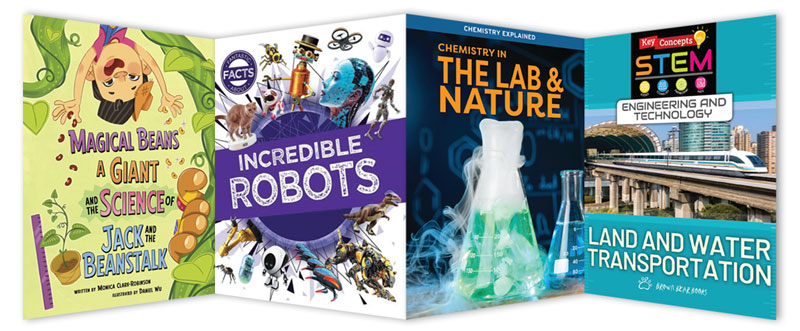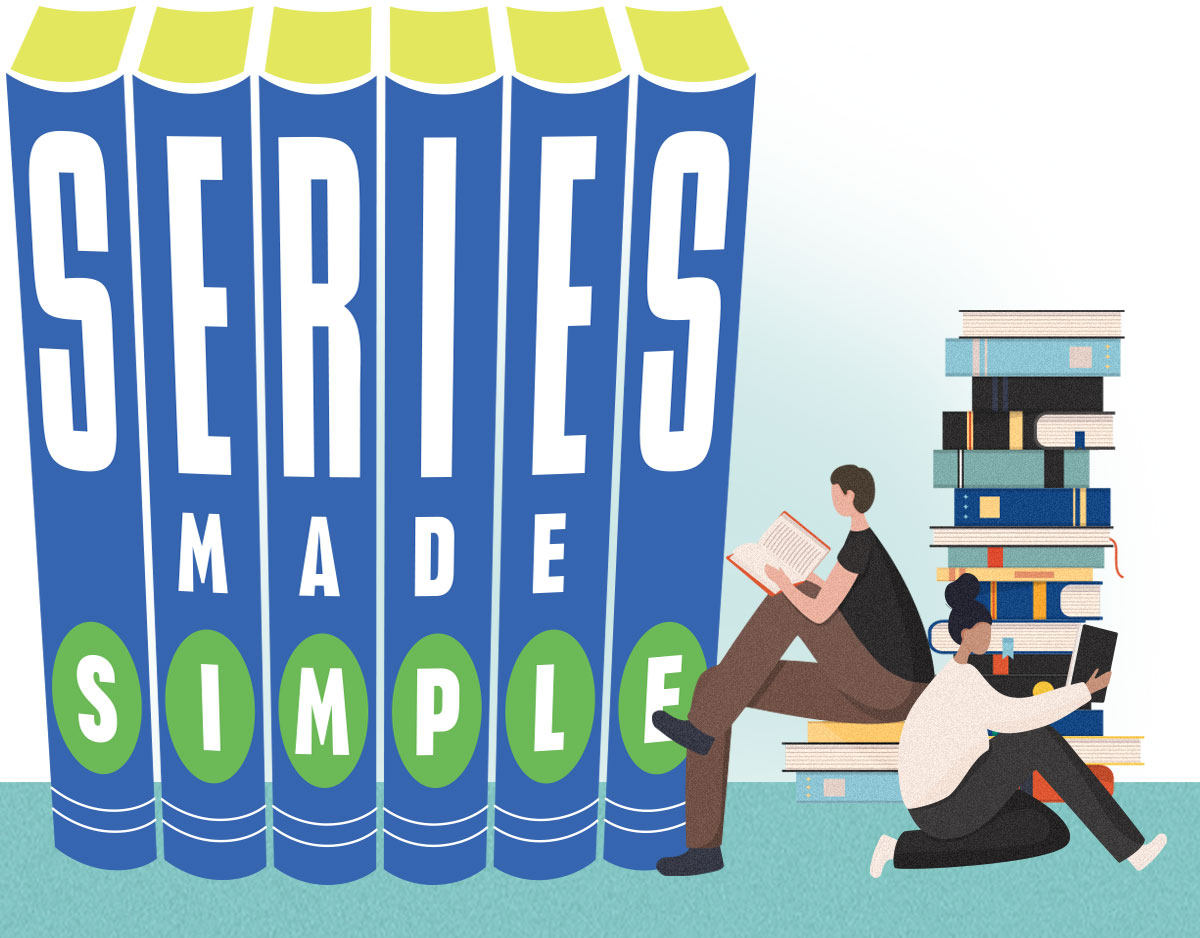Science Series That Will Put Readers in Orbit | General Science Series Nonfiction
Whether they are being shepherded through the solar system or challenged to disprove the events in a fairy tale, students will find their observation skills widened and their knowledge expanded with these series.

Young readers can gaze in wonder at photographs of distant nebulas or laugh at the silly jokes of a cartoon crocodile all while learning math and science this season. A continued increase in diverse representation can be seen in the photos and illustrations, as well as an increase in online content to support learning. Various series offer detailed instructions for experiments, reminders of the scientific method, and a barrage of facts about a wide range of topics. Whether they are being shepherded through the solar system or challenged to disprove the events in a fairy tale, students will find their observation skills challenged and their knowledge expanded.
Elementary
Andrews, E.C. Jupiter. ISBN 9781534549777.
––––. Mars. ISBN 9781534549807.
––––. Neptune. ISBN 9781534549869.
––––. Venus. ISBN 9781534549951.
Banks, Rebekah. Saturn. ISBN 9781534549890.
––––. Uranus. ISBN 9781534549920.
Mather, Charis. Earth. ISBN 9781534549746.
––––. Mercury. ISBN 9781534549838.
ea vol: 24p. (Solar System Explorers). Greenhaven/KidHaven. Aug. 2025. Tr $26.23.
Gr 1-3–Cartoon-style astronauts, one boy and one girl, guide readers through a tour of the solar system. Each title uses colorful photographs and helpful diagrams to introduce the planets. The temperature and size of the planet, the length of its day and year, and its location in the solar system are all covered. There are also descriptions of each planet’s atmosphere and what is known about its surface or inner layers. Other pages look at the various satellites around the planets and discuss whether life might exist there. The main text is three or four sentences per page with additional facts shown in starburst shapes. Glossary terms appear in a contrasting color font within the text. The young astronauts make funny comments like warning readers to “Hold onto your space helmets, explorers!” VERDICT A basic introduction to planetary facts for early elementary classrooms or libraries.
Clark-Robinson, Monica. A Just-Right Bed and the Science of Goldilocks and the Three Bears. illus. by Dusan Pavlic. ISBN 9798875216541.
––––. Magical Beans, a Giant, and the Science of Jack and the Beanstalk. illus. by Daniel Wu. ISBN 9798875216626.
Koster, Gloria. A Huff-and-Puff Proof House and the Science of the Three Little Pigs. illus. by Daniel Wu. ISBN 9798875216787.
––––. A Tiny Vegetable, Many Mattresses, and the Science of the Princess and the Pea. illus. by Dusan Pavlic. ISBN 9798875216701.
ea vol: 32p. (The Science of Fairy Tales). Capstone/Picture Window. Aug. 2025. Tr $27.32.
K-Gr 2–Each title in this series follows a simliar format: the scientific method is presented, a familiar story is retold in a humorous way, and the main character puts science to work. The third little pig demonstrates that air can move some materials more easily than others. Golda Locke shows that observation can help determine which porridge is the right temperature to eat, while a princess proves three peas cannot be felt under 20 mattresses. Every book ends with a kid-friendly experiment for readers to try on their own, such as testing whether a heavy object would have fallen from the beanstalk faster than a lighter object. The books have cartoon-style illustrations that fit the lighthearted approach. Readers are sure to notice that Red Riding Hood, the Gingerbread Boy, and other characters are at the market when Jack goes to sell his cow. VERDICT These books are an entertaining way to introduce the scientific method and would be a fun way to kick off a STEM activity.
Davis, Bela. Break It Up!: Sharing with Fractions. ISBN 9798384905073.
––––. How Big?!: Measuring and Comparing. ISBN 9798384905080.
––––. It’s About Time!: Counting Minutes and Hours. ISBN 9798384905097.
––––. Making Change!: Working with Money. ISBN 9798384905103.
––––. A Perfect 10!: Working with Numbers. ISBN 9798384905110.
––––. Shape Up!: A Geometry Adventure. ISBN 9798384905127.
ea vol: 24p. (Mighty Math). ABDO/Abdo Kids Junior. Aug. 2025. Tr $32.79.
PreS-Gr 2–Fractions, measurement, time, and money—basic math concepts of all sorts are explored in this series. Full-color photographs show children counting coins, sorting Halloween candy, and other everyday events that relate to math. A few sentences of text per spread are balanced by colorful images. Sidebars marked “Think” offer word problems for readers to work out; an answer key is provided in the back matter. Glossary terms appear in a contrasting color font and are defined in the back with words and images. “Hints” and “Notes” offer more details such as suggesting rounding off prices to make it easier to estimate or explaining that squares are a special type of rectangle. Readers may access online resources with a QR code to find videos, printable activities, or craft ideas to extend learning. VERDICT An easily accessible series for young readers with diverse representation in the illustrations.
MacCarald, Clara. How Do Galaxies Form? ISBN 9798892138499.
––––. What Are Exoplanets? ISBN 9798892138581.
––––. What Causes a Supernova? ISBN 9798892138529.
––––. What Was the Big Bang? ISBN 9798892138550.
––––. Where Do Asteroids Come From? ISBN 9798892138611.
––––. Where Do Black Holes Go? ISBN 9798892138642.
ea vol: 24p. (Cosmos Questions). Jump!/Pogo. Aug. 2025. Tr $29.99.
Gr 2-5–Stunning photographs bring cosmic phenomena to life in this series. Whether it is a view of a distant nebula or the Milky Way, each image will capture readers’ attentions. The text explains the size of asteroids, how scientists search for exoplanets, and other facts. Images have helpful labels and there are also sidebars with additional details like, “There are three types of black holes.” Each title includes an infographic which may compare the size of asteroids or list the categories of exoplanets. Every book ends with an activity for further exploration; readers may create their own model of a nebula or use a balloon to show how the universe is expanding. A glossary and index are in the back matter, along with directions on how to access additional resources through the publisher’s Fact Surfer website. Tips for parents and educators are also included in each title. VERDICT A visually engaging series sure to be popular with young astronomers.
Singer, Warren. AI: Artificial Intelligence. ISBN 9781502675408.
––––. Incredible Robots. ISBN 9781502675439.
––––. Magnificent Oceans. ISBN 9781502675460.
––––. Spectacular Space. ISBN 9781502675491.
ea vol: 32p. (Fantastic Facts About…). Cavendish Square. Aug. 2025. Tr $30.21.
Gr 3-5–For students who cannot get enough facts and who wear out trivia or head-to-head comparison books, this series will do the trick. Each title is filled with full-color photographs of tardigrades, nanobots, or distant galaxies to capture the eye and draw readers in. Infographics explain Einstein-Rosen bridges, ocean zones, and underwater volcanoes. The text is broken into sections under subheadings, which eases readers into easily digestible chunks and lends itself well to browsing for special interest topics. Real-world examples are used to explore topics, such as robots that have been seen in movies, or how the night sky appears different in the northern versus the southern hemisphere. Back matter includes a glossary and index. VERDICT Useful quick reference books for enthusiasts about the subjects covered.
Upper Elementary to Middle School
Bingham, Janet. Chemistry in the Lab & Nature. ISBN 9798895774960.
––––. Chemistry in Use. ISBN 9798895774977.
––––. Elements & Compounds. ISBN 9798895774984.
––––. Molecules & Chemical Reactions. ISBN 9798895774991.
ea vol: 48p. (Chemistry Explained). Bearport/Ursa. Aug. 2025. Tr $31.95.
Gr 5-8–Everything from the water cycle to radioactivity is covered in these titles. Each spread explores a different topic, such as molecules or batteries. Text-heavy pages are balanced with pages featuring large images; a description of lab work faces a photo of a chemist working under a fume hood, for instance. The full-color photos include a diverse range of individuals. Real world examples, such as the use of chlorine to kill microorganisms in swimming pools or how electrolysis creates oxygen for the International Space Station, show the range of chemistry in action. Biographies of great chemists like Marie Curie or Alessandro Volta appear in sidebars. Back matter includes comprehension and reflection questions, a glossary, suggested reading, and a QR code for the publisher’s Fact Surfer website. The layout is similar to encyclopedia entries, which makes it easy to use for research projects. VERDICT A solid update to collections and helpful addition to science classrooms.
Lockwood, Sophie. Investigating Rocks. ISBN 9781668963753.
Mullins, Matt. Investigating Cells. ISBN 9781668963715.
Orr, Tamra B. Investigating Respiration. ISBN 9781668963746.
Rau, Dana Meachen. Investigating Light. ISBN 9781668963722.
Simon, Charnan & Ariel Kazunas. Investigating Water. ISBN 9781668963784.
Taylor-Butler, Christine. Investigating Magnets. ISBN 9781668963739.
––––. Investigating Solar Energy. ISBN 9781668963760.
––––. Investigating Sound. ISBN 9781668963777.
ea vol: 32p. (Science Investigations). Cherry Lake. Aug. 2025. Tr $33.50.
Gr 3-6–Looking for ideas for hands-on science activities? These titles all have step-by-step directions for six different investigations. The titles begin with an introduction to the topic and a review of the scientific method. Each experiment includes a brief discussion of the topic, a supply list, detailed instructions, and a conclusion. Young scientists can build a model of a human lung or observe the process of condensation. Sidebars tie in real-world examples, such as the use of magnetic forces to create maglev trains or encourage readers to find out even more. Photos and colorful illustrations support the explanations, and bold terms are defined in the glossary. A note to parents and teachers encourages supervision of the activities and a note to kids reminds them to ask for help. A list of suggested books and websites for further information is also included. VERDICT A useful set for classroom activities, STEM labs, or home exploration.
Mason, Paul. Animals. ISBN 9781482473858.
––––. Forces and Magnets. ISBN 9781482473889.
––––. Human Body. ISBN 9781482473919.
––––. Light. ISBN 9781482473940.
––––. Materials. ISBN 9781482473971.
––––. Plants. ISBN 9781482474008.
ea vol: 32p. (Quick-Fix Science). Gareth Stevens. Aug. 2025. Tr $28.27.
Gr 3-6–Join Snappy the Nile Crocodile as he explores common science questions about magnets, mirror images, or how plants spread. Snappy appears as a cartoon character and has a lot to say about science topics, although he is not always right. For instance, bones are not for crunching, they help humans stand up. The text uses the humor of Snappy’s opinions to make readers curious about how muscles work or why animals hibernate. Information is presented in chunks of text, image captions, and within Snappy’s dialogue. Photographs and colorful infographics show bees collecting pollen or how the human eye sees colors. Sometimes Snappy suggests an activity, such as testing out what a magnet can pick up, and he also asks questions to encourage reflection. Bold terms are defined in the glossary and there are suggested books and websites to find out more. VERDICT A good set to hand to students who are always asking questions about how and why.
Mason, Paul. In Engineering and Industry. ISBN 9781978545243.
––––. In Outer Space. ISBN 9781978545304.
––––. In the Animal Kingdom. ISBN 9781978545212.
––––. In the Human Body. ISBN 9781978545274.
––––. In the Rainforest. ISBN 9781978545366.
––––. On Planet Earth. ISBN 9781978545335.
ea vol: 32p. (Cause, Effect, Chaos!). Enslow. Aug. 2025. Tr $26.93.
Gr 3-6–Arrow diagrams direct the reader’s attention to the flow of events in this highly visual series. Each book begins with a brief explanation of cause and effect, then examples are given that relate to the book’s main topic. An engineering situation such as using the wrong concrete mixture can lead to the chaos of a collapsing building, but using the right type of steel can create a sturdy bicycle frame. Various scenarios, from the systems of the human body to space, are illustrated and explained along with the chaos that will result if things go wrong. The arrows help keep readers moving through the text in the right direction while the plentiful images help to hold their attention. Back matter includes a glossary, index, and suggestions for further reading. VERDICT A helpful set for classes studying cause and effect since it contains so many examples across different disciplines.
Upper Middle School to High School
Adams, William D. Breathe It In! The Chemistry of Air. ISBN 9780716673507.
––––. Drink It Up! The Chemistry of Water. ISBN 9780716673477.
––––. Far Out! The Chemistry of Space. ISBN 9780716673545.
––––. Rocky Reactions! The Chemistry of Rocks and Minerals. ISBN 9780716673569.
––––. Smashing! The Chemistry of Atoms. ISBN 9780716673484.
––––. Strong Bonds! The Chemistry of Building Materials. ISBN 9780716673521.
Cataliotti, Joseph P. Cool Chemicals! The Chemistry of Technology. ISBN 9780716673538.
––––. Personal Bonds! The Chemistry of Our Bodies. ISBN 9780716673552.
––––. Tasty Reactions! The Chemistry of Food. ISBN 9780716673491.
––––. Wild Reactions! The Chemistry of Nature. ISBN 9780716673514.
ea vol: 48p. (Aha! Academy: Chemistry). World Book. Jul. 2025. Tr $33.
Gr 7-9–Encyclopedia-style entries organize the information in these titles. A colorful banner holds the heading and a brief description for each spread. Subheadings break the rest of the text into smaller chunks. Myriad photos show soil pollution, desalination plants, and other uses of chemistry, while diagrams illustrate the processes being described. Sidebars include a “Career Corner” introducing possible jobs in chemistry related fields, “Tech Time” discussing current chemistry applications, and “Curious Connections” showing how chemistry relates to other fields like planetology. Each book includes an experiment, such as testing the material strength of various household items—a popsicle stick, plastic utensil, straw, etc. There are also questions to check for understanding with the answers provided on a separate page. VERDICT A useful purchase for chemistry classrooms; it covers many of the everyday applications for chemistry as well as the basic principles of the subject.
O’Daly, Anne. Engineering and Technology: Air and Space. ISBN 9781835720608.
––––. Engineering and Technology: Buildings and Structures. ISBN 9781835720615.
––––. Engineering and Technology: Land and Water Transportation. ISBN 9781835720622.
––––. Engineering and Technology: Medicine and Health. ISBN 9781835720639.
––––. Engineering and Technology: Military and Security. ISBN 9781835720646.
––––. Engineering and Technology: Power and Energy. ISBN 9781835720653.
––––. Physics: Electricity and Electronics. ISBN 9781835720783.
––––. Physics: Light and Sound. ISBN 9781835720790.
––––. Physics: Magnetism. ISBN 9781835720806.
––––. Physics: Matter, Energy, and Heat. ISBN 9781835720813.
––––. Physics: Mechanics. ISBN 9781835720820.
ea vol: 64p. (Key Concepts in STEM). Brown Bear. Jul. 2025. Tr $48.55.
Gr 8 Up–Colorful photos and diagrams explore inventions throughout history from drive belts on potter’s wheels to maglev trains to space tourism. Many of the books are arranged chronologically with advances in various areas such as flight traced from early kites to the space age, or healthcare from the prehistoric trepanning of skulls to cloning and gene therapy. Along with the main text there are plentiful sidebars: “Society and Inventions” discusses trends like cycling lanes in urban environments, “Facts and Figures” shares details like how much the biggest crane in the world can lift, and “Science Words” defines key terms like atmospheric pressure. Back matter includes a glossary, suggested books and websites for further research, an index, and many of the titles also have a timeline. VERDICT This series covers a wide variety of STEM topics and teachers looking for materials to demonstrate the relationship between society and technology may find it very helpful.
Although all these series have strong components like infographics or comprehension quizzes, two of them have something else in common. “The Science of Fairy Tales” (Capstone/Picture Window) lets readers see a familiar story from a different viewpoint and question whether events could really have happened the way they did. The narrator is the main character in the familiar story but values the scientific method. “Quick-Fix Science” (Gareth Stevens) also features a cartoon-style narrator, Snappy the Crocodile, who has a comment on just about everything. The humor of the characters and their observations invite students to see science as something to apply to everyday (or fairy tale) problems, and something to enjoy.

FALL 2025 SERIES MADE SIMPLE REVIEWS
RELATED
The job outlook in 2030: Librarians will be in demand
The job outlook in 2030: Librarians will be in demand
ALREADY A SUBSCRIBER? LOG IN
We are currently offering this content for free. Sign up now to activate your personal profile, where you can save articles for future viewing






Add Comment :-
Be the first reader to comment.
Comment Policy:
Comment should not be empty !!!